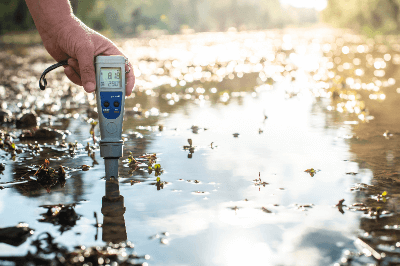What Is a Water Quality Analyzer?
 As the name suggests, a Water Quality Analyzer is an instrument designed to automatically measure the condition and properties of water.
As the name suggests, a Water Quality Analyzer is an instrument designed to automatically measure the condition and properties of water.
In essence, the instrument collects a sample of water from a specific location and places it in the instrument’s sample holder for analysis.
Although we have mentioned that it simply analyzes the properties of water, there are many items that can be measured.
The main items that can be measured are pH, turbidity, conductivity, salinity, and dissolved oxygen.
Some instruments can measure multiple of the items listed above, while others specialize in a single item.
Uses of Water Quality Analyzers
Water Quality Analyzers are used in various places where water is available, especially these days when environmental issues are being called for.
For example, water supply facilities are places where water sent from sewerage facilities is treated in order to send it back to homes and facilities. Water Quality Analyzers are installed to make sure that the treated water meets the required standards.
Water is also essential for the manufacture of products in factories. The water used in factories is dirty and must be treated within the factory to meet standards that allow it to be discharged.
At this point, Water Quality Analyzers are used to measure whether the water meets the effluent standards.
Principle of Water Quality Analyzer
The measuring principle of the Water Quality Analyzer depends on the item to be measured.
The pH is measured by the degree of potential difference between a standard solution and the water to be measured.
The main measuring principle for turbidity is to drop light into the water. The stronger the turbidity, the more light is reflected and scattered, and the less light is transmitted. The measurement is based on how much of this light is transmitted.
Conductivity is measured by measuring the electrical resistance of a standard potassium chloride solution, and the reciprocal of the resistance is the conductivity. The electric conductivity is obtained from the difference in electrical resistance to the potassium chloride solution.
The diaphragm electrode method is the most popular method for measuring dissolved oxygen.
A diaphragm is placed between the working electrode and the oxygenated water, allowing oxygen to permeate through the diaphragm. When oxygen permeates through the diaphragm, a reduction reaction occurs at the working electrode. This reaction causes an electric current to flow, which is measured to determine the oxygen concentration.
The main principle of measurement is described above. This type of measurement method is built into the main body of the Water Quality Analyzer, which measures the sample placed in the sample holder, sends the signal to the detector of the device, and displays each measured value.